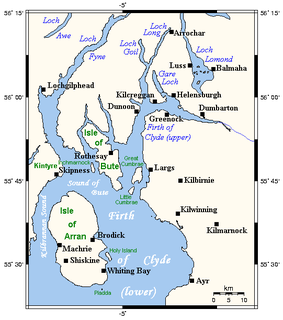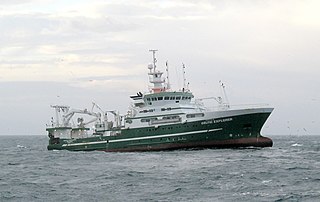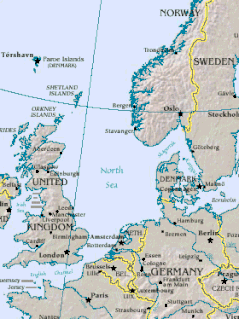
The Firth of Clyde is the mouth of the River Clyde. It is located on the west coast of Scotland and constitutes the deepest coastal waters in the British Isles. The firth is sheltered from the Atlantic Ocean by the Kintyre peninsula, which encloses the outer firth in Argyll and Ayrshire. The Kilbrannan Sound is a large arm of the Firth of Clyde, separating the Kintyre Peninsula from the Isle of Arran. Within the Firth of Clyde is another major island – the Isle of Bute. Given its strategic location at the entrance to the middle and upper Clyde, Bute played a vital naval military role during World War II.

Lamlash is a village on the Isle of Arran, in the Firth of Clyde, Scotland. It lies three miles south of the island's main settlement and ferry port Brodick, in a sheltered bay on the island's east coast, facing the Holy Isle. Lamlash is the seat of Arran's local government offices, and is also the location of the island's only police station, secondary school and hospital. In common with the rest of the island, the village's main industry is tourism and the public sector is also an important employer. Lamlash has an RNLI Lifeboat station with a B class Atlantic 75 lifeboat, covering the inshore waters around the coast of Arran, and in summer, there is a regular ferry service from Lamlash harbour to Holy Isle. The village has several buildings of historical interest, including Hamilton Terrace, which consists of two rows of idyllic single storey-and-attic cottages on the Lamlash seafront, arranged in pairs.

Bottom trawling is trawling along the seafloor. It is also referred to as "dragging". The scientific community divides bottom trawling into benthic trawling and demersal trawling. Benthic trawling is towing a net at the very bottom of the ocean and demersal trawling is towing a net just above the benthic zone. Bottom trawling can be contrasted with midwater trawling, where a net is towed higher in the water column. Midwater trawling catches pelagic fish such as anchovies and mackerel, whereas bottom trawling targets both bottom-living fish (groundfish) and semi-pelagic species such as cod, squid, shrimp, and rockfish.

The Firth of Lorn or Lorne is the inlet of the sea between the south-east coast of the Isle of Mull and the mainland of Scotland. It includes a number of islands, and is noted for the variety of wildlife habitats that are found. In 2005, a large part of the Firth became a Special Area of Conservation.

The fishing industry in Scotland comprises a significant proportion of the United Kingdom fishing industry. A recent inquiry by the Royal Society of Edinburgh found fishing to be of much greater social, economic and cultural importance to Scotland than it is relative to the rest of the UK. Scotland has just 8.4 per cent of the UK population but lands at its ports over 60 per cent of the total catch in the UK.

A fishing dredge, also known as a scallop dredge or oyster dredge, is a kind of dredge which is towed along the bottom of the sea by a fishing boat in order to collect a targeted edible bottom-dwelling species. The gear is used to fish for scallops, oysters and other species of clams, crabs, and sea cucumber. The dredge is then winched up into the boat and emptied. Dredges are also used in connection with the work of the naturalist in marine biology, notably on the Challenger Expedition.

Fishing in the North Sea is concentrated in the southern part of the coastal waters. The main method of fishing is trawling.
This page is a list of fishing topics.
The following outline is provided as an overview of and topical guide to fishing:
This is a glossary of terms used in fisheries, fisheries management and fisheries science.

As with other countries, the 200 nautical miles (370 km) exclusive economic zone (EEZ) off the coast of the United States gives its fishing industry special fishing rights. It covers 11.4 million square kilometres, which is the second largest zone in the world, exceeding the land area of the United States.
The North Pacific Fishery Management Council (NPFMC) is one of eight regional councils established by the Magnuson–Stevens Fishery Conservation and Management Act in 1976 to manage the fisheries of the United States. With jurisdiction over the 900,000-square-mile (2,300,000 km2) Exclusive Economic Zone (EEZ) off Alaska, the Council has primary responsibility for groundfish management in the Gulf of Alaska, Bering Sea and Aleutian Islands, including cod, pollock, flatfish, mackerel, sablefish, and rockfish species. Other large Alaska fisheries such as salmon, crab and herring are managed primarily by the State of Alaska.

The Gulf of Maine has been fished since the 1700s, and has been a historic fishing area since. Climate change is having significant impacts on this ecosystem; between 2004 and 2013, the Gulf of Maine has warmed faster than 99.9% of the global oceans, increasing average temperature by 2 °C (3.6 °F). Having seen the depletion of groundfish stocks starting in the early 1990s, managers took care to create five closure areas in the Gulf of Maine.
Howard Wood OBE is a Scottish environmentalist, co-funder of Community of Arran Seabed Trust (COAST) and Goldman Environmental Prize winner in 2015.
The marine protected areas of South Africa are in an area of coastline or ocean within the exclusive economic zone (EEZ) of the Republic of South Africa that is protected in terms of specific legislation for the benefit of the environment and the people who live in and use it. An MPA is a place where marine life can thrive under less pressure than unprotected areas. They are like underwater parks, and this healthy environment can benefit neighbouring areas.

In Scotland, Marine Protected Areas (MPAs) are areas of sea defined so as to protect to habitats, wildlife, geology, undersea landforms, historic shipwrecks, and to demonstrate sustainable management of the sea. As of December 2020, approximately 37% of Scotland's seas are covered by the Scottish MPA network, which comprises 244 sites in total.

Loch Sunart to the Sound of Jura Marine Protected Area is a Marine Protected Area (MPA) off the west coast of Scotland. The MPA, which covers 741 km2 (286 sq mi), includes the waters of Loch Sunart, the Sound of Mull, the Firth of Lorne and the Sound of Jura. It has been designated to protect the population of common skate and the area's quaternary geological features. The MPA is designated a Category IV protected area by the International Union for Conservation of Nature.

The marine conservation zones in Yorkshire, were created in 2016 and 2019 after an extensive consultation, which drew criticism of the UK Government's plans which designated only 31 zones out of the projected 127 zones in 2013. An £8 million study recommended the 127 sites, of which, eight lay in and around the coast of Yorkshire.
Laxey Bay is a coastal feature and Marine Nature Reserve on the east coast of the Isle of Man in the north Irish Sea. Geographically it is bounded by Laxey Head to the north and Clay Head to the south.
The fishing vessel Antares was a pelagic trawler based in Carradale, Kintyre in the United Kingdom. She was fishing off the coast of the Isle of Arran on 22 November 1990 when she foundered with the loss of four crew members after her trawl line was snagged by Royal Navy Trafalgar class nuclear powered submarine HMS Trenchant. An investigation by the Marine Accident Investigation Branch concluded that the accident had been caused by "a partial breakdown in both the structure and the standards of watchkeeping on board Trenchant".














